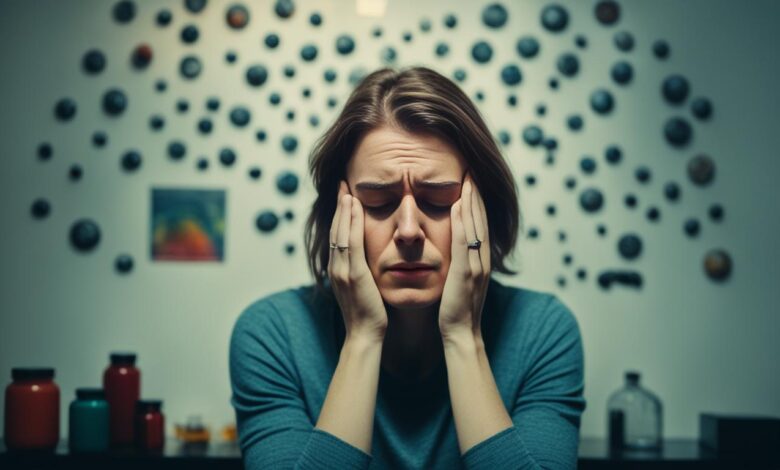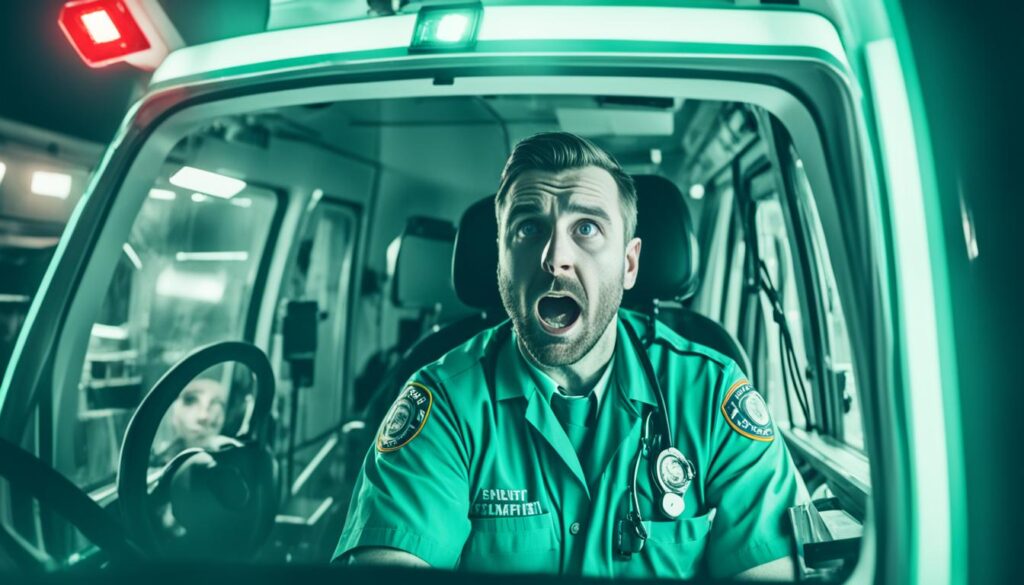Recognizing Anxiety Attack Signs: Vital Tips

About 40 million American adults deal with anxiety disorders.
Anxiety attacks can greatly affect those who get them. Knowing the early signs helps give the right support. This can make a big difference during these hard times.
We’re going to look at signs of anxiety attacks, how they differ from panic attacks, and why they happen. We’ll also cover ways to lessen their effects. Let’s start by learning about the key signs and symptoms of anxiety attacks.
Understanding Panic Attacks vs. Anxiety Attacks
It’s common to mix up panic attacks and anxiety attacks, but they are different. Knowing the differences helps with the right diagnosis and treatment. Both can be very distressing.
The Nature of Panic Attacks
Panic attacks can start suddenly, without warning. They get intense very fast, often in minutes. People having a panic attack might feel extreme fear, like they’re having a heart attack or facing death. Symptoms include a fast heartbeat, difficulty breathing, chest pain, shaking, and fearing something terrible will happen. These attacks are scary and confusing.
The Development of Anxiety Attacks
Anxiety attacks build up more slowly and can last a lot longer, from days to months. They’re usually linked to mental health issues like anxiety disorder or PTSD, or come after a traumatic event. Symptoms can be physical too, like a faster heartbeat and tense muscles. But mainly, it feels like severe worry, nervousness, and fear that won’t go away.
Understanding these differences is crucial for healthcare providers. This way, they can make accurate diagnoses and suggest treatments that really help each person.
| Panic Attacks | Anxiety Attacks |
|---|---|
| Rapid onset and peaking within minutes | Slower development over days, weeks, or months |
| Feels like a heart attack or life-threatening situation | Excessive worry and an overwhelming sense of dread |
| No clear trigger | Often associated with an underlying mental health condition or trauma |
| Physical symptoms: rapid heartbeat, shortness of breath, chest pain or discomfort, trembling or shaking | Physical symptoms: increased heart rate, muscle tension |
Causes of Anxiety Attacks and Panic Attacks
Panic and anxiety attacks don’t have one clear cause. However, several factors can trigger them. Understanding these triggers helps treat these conditions. Let’s explore some common causes:
Genetic Factors and Major Life Shifts
There might be a genetic link to panic attacks, as they can run in families. If a family member has them, your risk may increase. Major life changes like getting a new job, marriage, or losing someone can also lead to these attacks.
Consistent Stressors and Traumatic Events
Consistent stress from work, financial issues, or relationship troubles can lead to anxiety attacks. These stressors build up over time. Traumatic experiences like accidents or abuse can trigger panic and anxiety attacks as well.
Medical Conditions and Medications
Some medical conditions contribute to panic attacks. For example, hyperthyroidism increases thyroid hormones, leading to panic symptoms. Stopping certain medications suddenly or using stimulants like caffeine can provoke panic attacks too.
Understanding these causes is key to managing and treating panic and anxiety attacks. Remember, getting professional help is important for managing these conditions effectively.
| Causes of Anxiety Attacks | Causes of Panic Attacks |
|---|---|
| Consistent stressors | Genetic factors |
| Traumatic events | Major life shifts |
| Medical conditions (e.g., hyperthyroidism) | Consistent stressors |
| Medical conditions (e.g., medication withdrawal, stimulant use) |
Coping Strategies for Anxiety Attacks
When you face an anxiety attack, there are effective strategies to help you. These methods can ease symptoms and bring relief. They allow you to take control and move through the attack smoothly.
Slowing down breathing: A key strategy is to slow your breathing. Taking slow, deep breaths helps regulate your body’s reaction to anxiety. It leads to relaxation. Focusing on your breath reduces panic and anxiety feelings.
Observing sensations: Observing sensations is useful during an attack. It means recognizing physical and emotional feelings without trying to change them. This mindset helps let the sensations pass on their own.
Practicing mindfulness exercises: Mindfulness, like meditation, helps manage anxiety attacks. It keeps you in the present, reducing anxious thoughts. Regular practice builds strength and improves wellbeing.
Focusing on a single object: Diverting your attention to one object can help. It shifts focus from anxiety to something solid and steady. This interrupts anxiety cycles, bringing stability.
Relaxing muscles one at a time: Progressive muscle relaxation involves tensing and then relaxing muscles. This technique reduces physical anxiety symptoms by releasing tension.
Anxiety attacks are temporary and will pass. Responding gently and logically can soften the experience. These strategies offer relief and help you handle anxiety attacks well.
| Coping Strategies for Anxiety Attacks |
|---|
| Slowing down breathing |
| Observing sensations |
| Practicing mindfulness exercises |
| Focusing on a single object |
| Relaxing muscles one at a time |
These strategies help you proactively manage anxiety attacks. With practice, they become powerful tools for mental health and relief from anxiety.

Helping Someone During a Panic Attack
Seeing someone have a panic attack is tough. However, you can support them in many ways. Keep calm, help them breathe slowly, change their focus, show them how, and give kind support. These actions can lessen their stress and bring them back to calm.
Remaining calm is key when aiding someone in a panic attack. Showing panic yourself makes things worse. Breathe deeply and stay positive to offer them safety.
Encouraging them to breathe slowly can lessen the panic’s strength. Remind them to take deep breaths and release them slowly. Suggest they pay attention to their breathing as a way to stay grounded.
Redirecting their focus can distract them during the attack. Suggest they concentrate on something calming or a familiar sound. This shift in focus can help them feel in charge again.
Leading by example shows them how to handle their panic. Show calmness, breathe deeply, and use calming methods yourself. Your calmness can comfort them.
Offering support and encouragement helps a lot during a panic attack. Tell them panic attacks are common and they’re not alone. Remind them there’s no shame and getting professional help is smart for future prevention.
Helping someone through a panic attack is very valuable. Stay calm, encourage them to breathe, distract them, be a calming example, and show care. Your help and care can teach them how to cope better and take control of their anxiety.
Overcoming the Stigma of Panic Attacks
Panic attacks often come with the belief that those who have them are weak. This is not true and is harmful. We need to educate and spread awareness to change this view.
Teaching people about how common panic attacks are can help. It shows that anyone can have them, no matter how strong they are. This can help erase the false idea that those who experience panic attacks are weak-minded.
It’s also key to make it known that panic attacks are a real and serious issue. By sharing how tough the symptoms are and how they affect lives, we can fight the belief that panic attacks are nothing to worry about.
“Panic attacks are an intense and overwhelming experience. They can be incredibly distressing and debilitating for those who experience them. It is vital that we support and help individuals going through these challenging moments.”
Getting support is vital in fighting the stigma around panic attacks. Creating kindness and understanding helps those affected feel better supported. This support can be as simple as listening and offering kind words.
By fighting this stigma, we make a society that’s more caring and helpful. It’s important to see the bravery in seeking help and coping with panic attacks. Together, we can spread empathy and aid for those dealing with panic attacks.
Breaking down the stigma of panic attacks opens the door to better mental health understanding. Working together, we can end the stigma, aid those affected, and push for a healthier community for everyone.
Panic Attacks in Emergency Medical Services (EMS)
Panic and anxiety attacks can be hard to tell apart for EMS providers. Knowing the difference is key to the right medical care.
Panic attack in EMS: During a call, EMS may meet people having a panic attack. This involves sudden, intense fear or distress and physical signs like a fast heartbeat and chest pain.
Panic attack management in EMS: To handle these attacks well, EMS should use certain steps:
- Assessment: Review the patient’s health and mindset thoroughly to check for health issues or danger.
- Separating the patient from triggers: Try to remove them from what’s causing the episode. This helps them feel safe and may lessen the attack.
- Establishing eye contact: Keeping eye contact reassures the patient and helps them feel connected during the scary moment.
- Legitimizing the emergency: Let the patient know their symptoms are real and can be treated. This reduces their worry.
- Modeling calm breathing: Show them how to breathe slowly and deeply. This can make their breathing easier and calm their anxiety.
“By understanding the unique challenges of panic attacks in EMS, providers can offer empathetic and effective care to individuals experiencing these episodes.”
Following these methods, EMS can help those feeling panic or anxiety. This support can ease their distress and aid in their recovery.

Relieving Panic Attack Symptoms
When you have a panic attack, it’s key to manage symptoms to feel in control again. There are several ways to reduce the effects of a panic attack. Recognize the signs early, focus on your breathing and use grounding and muscle relaxation techniques. Finding soothing or distracting activities helps too.
Recognizing that it is a panic attack
Understanding you’re having a panic attack is the first step. Knowing the fear and discomfort is only temporary helps. It’s not a sign of something more dangerous happening.
Paying attention to breathing
People often breathe fast and shallow during a panic attack. Taking slow, deep breaths can help you feel less anxious. Breathe in through your nose and out through your mouth slowly.
Practicing grounding techniques
Grounding techniques can help you stop focusing on negative feelings. Try the 5-4-3-2-1 method. It involves noting five things you see, four you can touch, three you hear, two you smell, and one you taste. This helps bring your mind to the present.
Using muscle relaxation techniques
Progressive muscle relaxation helps ease tension. Tense up and then relax each muscle group. Start from your head and move down to your toes. It helps make your body feel calm and can ease symptoms.
Engaging in soothing or distracting activities
Find activities that comfort you or take your mind off the panic. Listening to calm music, deep breathing, or saying positive things to yourself can help. Trying hobbies like drawing or reading might also provide relief. Choose what makes you feel relaxed and distracted.
Talking to friends, family, or a therapist can be very helpful. They can provide support and advice. If panic attacks are severe, talking to a doctor about medication might also be a good idea. They can give you extra support and relief.
Tips for Relieving Panic Attack Symptoms
| Technique | Description |
|---|---|
| Deep Breathing | Focusing on slow, deep breaths to regulate breathing patterns and reduce anxiety. |
| Grounding Techniques | Engaging the senses to redirect attention to the present moment and away from panic symptoms. |
| Muscle Relaxation | Progressive muscle relaxation exercises to release tension and promote overall relaxation. |
| Soothing or Distracting Activities | Engaging in activities that promote relaxation or divert attention from panic attack symptoms. |
| Seeking Support | Reaching out to trusted individuals or professionals for understanding and guidance. |
| Considering Medication | Seeking professional guidance to explore medication options for severe cases. |
Reducing Symptoms of Anxiety Attacks
Anxiety attacks can be scary. But, there are ways to feel better and take back control. Learning how to ease anxiety is key for feeling good in the long run.
Deep breathing can really help during an anxiety attack. Taking slow breaths makes your body relax. Doing this every day can help stop an attack in its tracks.
Relaxation techniques like muscle relaxation or imagining peaceful scenes are great, too. They calm your mind and body. This helps you feel in control again.
Fighting off negative thoughts is another way to beat anxiety. Anxious thoughts make attacks worse. Changing how you think can cut down on anxiety.
Being in the present also helps during an attack. Focus on what’s happening right now, not on your worries. Mindfulness and grounding exercises are good for this.
Seeking support from people you trust is important. Talking to friends, family, or a therapist brings comfort. It’s key to have people who understand what you’re going through.
In serious cases, medication might be needed. A doctor can prescribe meds to help. Always talk to a doctor about what’s best for you.
Trying these steps can really improve life for those with anxiety. Taking action against anxiety leads to empowerment. It means you’re in charge of your mental health.
| Anxiety Attack Relief Strategies | Effectiveness |
|---|---|
| Deep breathing exercises | Highly effective |
| Relaxation techniques | Effective |
| Challenging negative thoughts | Effective |
| Staying in the present moment | Effective |
| Seeking support | Highly effective |
| Considering medication | Dependent on the individual |
Understanding Panic Disorder and Agoraphobia
Panic disorder happens when people have frequent panic attacks. These lead to big life changes and ongoing worry. The disorder involves intense fear and discomfort, shown by physical symptoms. People may feel their heart race, have trouble breathing, or shake.
These panic attacks can be so severe that people avoid places or activities. They fear having more attacks. This can stop them from doing things they enjoy or need to do.
Agoraphobia often comes with panic disorder. It’s the fear of being in situations where leaving is hard. People with this fear might stay away from crowded spaces or public transport. They might also avoid being by themselves away from home. These places can make their anxiety and panic worse.
Knowing the signs of panic disorder and agoraphobia is important. This way, you can get the right help. Signs of panic disorder include:
Frequent panic attacks that happen without warning
Being very afraid of another panic attack and the feelings it brings
Worry about the effects of panic attacks
Staying away from places or activities because they might cause panic
Making big changes in how you live to avoid anxiety-inducing situations
If you or someone you know keeps having panic attacks or shows these signs, get help. Talk to a doctor or mental health expert. They can assess the situation and create a treatment plan just for you.
Conclusion
Panic attacks and anxiety can make life tough, but there’s hope. With the right coping methods and support, you can get better. It’s also key to fight the stigma around these issues. This helps create a caring space for those in need.
Getting help from a professional is key to dealing with these problems. Experts can guide you and may suggest therapy or medicine. This gives you the tools to get better. Remember, it’s possible to feel better with the right help.
Looking after your mental health is crucial, through self-care, therapy, or medication. Making these steps a priority helps improve your mental health. Taking action can give you a fulfilling life, beyond the challenges of panic and anxiety attacks.






